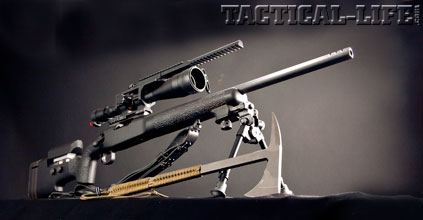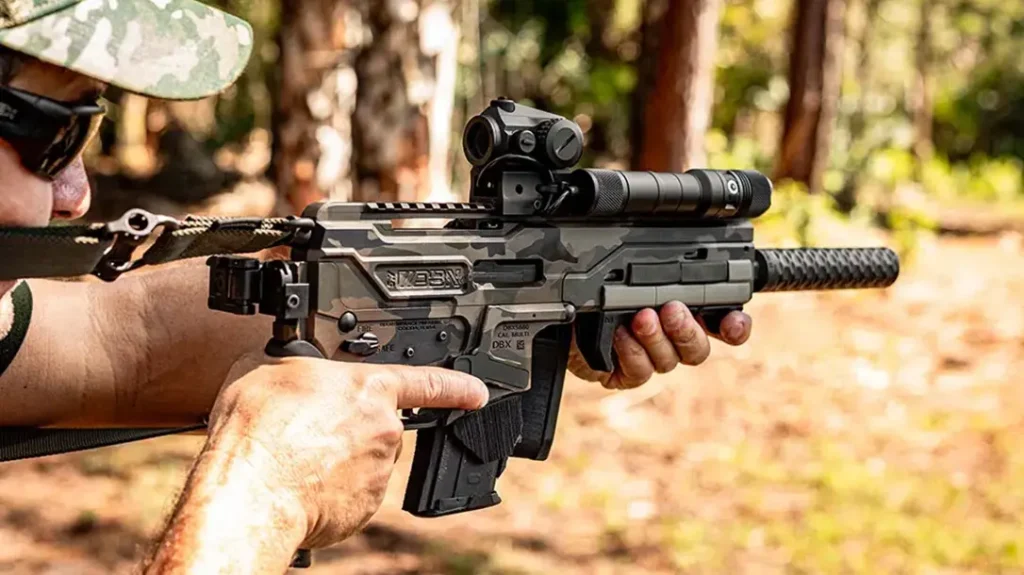Since Remington’s classic Model 700 was introduced in 1962, it has been a mainstay of civilian, military and law enforcement users. The Model 700 action is so strong and easily enhanced for improved performance that it has served as the basis for both the US Army and US Marine Corps’ sniper rifles. The Army’s M24 and the Marines’ M40 series and it is still serving on the overseas battlefields in Afghanistan and Iraq and at home with law enforcement snipers. The 700 in one version or another has always been among the precision tactical rifles most often chosen by both police and military snipers. Remington’s latest iteration of the classic 700 marks a somewhat different direction for the rifle, but before we get into the VTR, let’s examine the overall Model 700 line-up for law enforcement.
The Model 700 has been in service for nearly 50 years and shows no signs of being replaced. It remains one of the best bolt-action rifle designs in history and Remington keeps improving the breed, so today’s 700 is actually better than earlier ones. There are many versions of the 700 available to suit just about every law enforcement requirement. Our test rifle is the latest 700 VTR with a few modifications we added, so we’ll leave a detailed description until later.
The Remington 700 VTR that is the basis of our test begins with the bolt-action design. The bolt face, barrel and receiver surround and support the cartridge with three concentric circles of ordnance steel. The receiver is machined from a block of solid steel and drilled and tapped for scope mounts. The magazine floor plate is hinged to facilitate ammo dumps when necessary. The new Remington triangular profile barrel is 22 inches in length with an integral muzzle brake and match muzzle crown. The muzzle brake reduces muzzle rise and makes follow-up shots faster than standard barrels. The patent pending triangular barrel reduces weight over cylindrical barrel of equivalent length. It adds some rigidity when compared to a barrel of equal weight, but isn’t necessarily more rigid than a traditional barrel.
Advertisement — Continue Reading Below
The 700 VTR stocks made of polymer are available in several colors. Our test rifle came with an olive green stock and three sling swivel studs; two of which are typically used for the sling and the other for mounting a bipod. The 700 VTR is available in .223 Remington (5.56x45mm) and .308 Winchester (7.62x51mm).
 X-Mark Pro Trigger
X-Mark Pro Trigger
The VTR’s trigger is the recently introduced X-Mark Pro trigger. While original 700 triggers weren’t bad, they usually had to be adjusted or replaced with an aftermarket trigger to suit the requirements of the user. Those days are now history. Remington’s X-Mark Pro trigger takes the Model 700 to new levels of performance. Remington’s claims that the X-Mark Pro trigger has out of the box performance on a par with many custom triggers which at first aroused our skepticism, but after testing our 700 VTR’s new trigger, the skepticism evaporated like morning mist on a summer’s day.
So just how good is this new trigger? Remington technical personnel tell us that production triggers will be set to a nominal pull weight of 3.5 to 5 pounds. Our test trigger broke with zero creep or backlash at just over 5 pounds, but it felt lighter and the rifle was remarkably accurate right from the box. With a proper break in and the trigger adjusted to a lower pull rate, the 700 VTR should be even more accurate. If this were our rifle, though, we’d drop the trigger pull to 3.5 to 4 pounds. Procedures to adjust the 700P’s X-Mark Pro trigger are beyond the scope of this article and should not be undertaken by anyone who hasn’t been trained in the process.
Advertisement — Continue Reading Below
The bottom line is if you don’t like the pull weight of the X-Mark Pro from the box, take the rifle to a gunsmith or your department armorer to have the trigger pull adjusted. It is a quick and simple process, but for law enforcement use, we do not recommend triggers with pull weights of less than 3 pounds. Like earlier Remington Model 700 triggers, the X-Mark Pro safety blocks both the sear and trigger. Because of the foregoing improvements in manufacturing, the X-Mark Pro trigger can be safely set be as much as 40 percent lighter than earlier triggers.
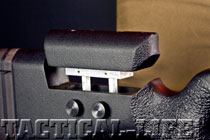 McMillan A5 Stock
McMillan A5 Stock
Although the standard stock would probably be good enough for most purposes, tactical use requires that the rifle be tailored to the individual shooter via an adjustable cheek rest and length-of-pull (LOP) for optimum eye relief. We ordered a McMillan A5 Tactical stock to bring our 700 VTR into full tactical configuration.
The A5 is one of McMillan’s most popular tactical stocks and has options to suit just about any precision shooter. The receiver area is inletted using precision computer numerical controlled (CNC) machinery and is bedded with aircraft aluminum bedding blocks for rigidity. The rifle’s barrel is fully free floated. Needless to say, the Remington action was a perfect fit into the McMillan stock.
Advertisement — Continue Reading Below
The A5 fore-end is a full beavertail for enhanced grip and better stability when shooting off a bag. The cheek rest is fully adjustable as is the LOP via spacers, although the as issued LOP was as close to perfect as we could want since our arms are somewhat longer than most. (Our knuckles do not, however, drag the ground!) The butt hook facilitates pulling the stock firmly back into the shooter’s shoulder for increased stability and thus accuracy.
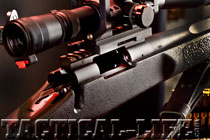 Brownells MIL-STD-1913 Rail
Brownells MIL-STD-1913 Rail
We try to set up every rifle we evaluate to as close as possible to what real snipers might choose for their personal duty weapon. We have undergone basic law enforcement sniper training, worked extensively with both military and law enforcement snipers and so have a “feel” for what many choose for their personal shooting system. Most snipers of our acquaintance tailor their rifles to their personal tastes and operational requirements. Our shooting system consists of the following items that follow. First was a mounting rail from Brownells. Our 700 VTR was drilled and tapped, but had no mount. We prefer a MIL-STD-1913 mount that mates to our LaRue Tactical scope mount and so ordered a MIL-STD 1913 mount from Brownells.
We set our Remington VTR up with a Leupold Mark 4 6.5-20 scope with a Horus Vision H25 reticle. The Horus Vision reticle was originally developed for long range hunting. The reticle in our scope, designed by a military sniper instructor, was primarily designed for military and law enforcement uses. This excellent tactical optic has remarkable clarity and light gathering capability, along with 70 minutes of angle (MOA) adjustment in both windage and elevation. The Horus Vision Sighting System has achieved notable success in both Afghanistan and Iraq. In essence, Horus Vision scopes eliminate dialing in clicks of elevation or windage, and are calibrated in standard milliradians, but without the Mil-Dots. Each milliradian is subtended into 0.2 milliradian increments, so that range estimation using the mil system is far more precise than with standard Mil-Dots.
Advertisement — Continue Reading Below
Take a look at these 3 Must-Have Pieces of Leupold Optics Gear For Every Shooter
Instead of dialing in clicks of elevation or windage, scopes with Horus Vision reticles use a targeting grid that initially looks busy, but soon becomes second nature. To use the system, the shooter generates “come-up” card data using the Horus Vision handheld PDA computer or one’s own personal computer. If time is available and more exact precision is desired, the Horus PDA can be used to generate ballistic targeting data, to include elevation and windage holds for the target to be engaged. For most engagements, however, the come up card is satisfactory and is incredibly fast and precise. The Horus Vision system takes all the guesswork and estimation out of holdovers necessary for long range shooting.
Once the rifle is zeroed with one load, a PC or the PDA can be used to generate come-up cards for other loads. It also enables the rifleman to use a variety of loads without touching his scope turrets. All that is necessary is to generate a come-up card for any load desired and confirm zero. The Horus system also allows law enforcement precision marksmen to use supersonic and subsonic ammunition interchangeably without scope adjustment. All that is necessary is to develop two come up cards using the Horus PDA. US Army Special Forces snipers in Afghanistan and Iraq have given it unsolicited praise and have made “kills” at ranges that are considered nearly impossible with standard Mil-Dot systems. At the 2009 SHOT (Shooting, Hunting, Outdoor Trade) show, we were informed by a Special Forces Colonel friend that the entire special operations community was going to change over to the Horus Vision reticle.
Advertisement — Continue Reading Below
Leupold RX II & RXIII Rangefinder
We believe that MIL-Dot reticles are ready to be added to the trash heap of shooting history. Today’s laser rangefinders are much more accurate and dependable than early versions. Most active snipers tell us that they use lasers rather than outdated MIL-Dots. Laser rangefinders like Leupold’s RX II and RX III rangefinders and newest RXB-IV rangefinding binoculars do much more than just indicate range. They calculate true ballistic range when shooting on a slope, either up or down. Previously, this required a mathematical calculation that was simple but took time.
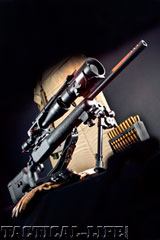 The RX rangefinders display this critical information instantly, which is especially valuable in operations where slope shooting is required in places such as Northern Afghanistan. Special Forces operators of our acquaintance tell us that they use laser rangefinders almost exclusively in this operational area because Mil-Dots just take too much time. In fact, every sniper we know uses a laser rangefinder to determine target distance.
The RX rangefinders display this critical information instantly, which is especially valuable in operations where slope shooting is required in places such as Northern Afghanistan. Special Forces operators of our acquaintance tell us that they use laser rangefinders almost exclusively in this operational area because Mil-Dots just take too much time. In fact, every sniper we know uses a laser rangefinder to determine target distance.
The other purpose of Mil-Dots is hold overs for distance and hold offs for windage. Once again, technology has overtaken Mil-Dots. In this case, Mil-Dots have been surpassed by the Horus Vision Sighting System (HVS) mentioned above. The HVS takes Mil-Dots to the next step with a targeting grid in standard milliradians. With each milliradian subtended into 0.2 mil increments holds are much more precise than with Mil-Dots. The HVS grid can be used for precise hold overs and for windage adjustment without touching the adjustment knobs. Once the rifle is zeroed with the HVS, the elevation and windage knobs are never again touched.
Advertisement — Continue Reading Below
The second part of the HVS system is a Palm handheld computer, which comes installed with HVS ballistic software. This is used to generate an adhesive backed come up card that is can be attached to the rifle’s buttstock or kept in the shooter’s data book. Once the ballistic data are confirmed for the basic cartridge, the PDA can be used to calculate a come up card for any load and the grid is used to determine holds, rather than clicking the windage and elevation knobs. All that is necessary is to enter the data, transfer the ballistic solution to the card and confirm zero. This is especially useful for snipers who must use both supersonic and subsonic ammunition.
Leupold Mark 4 12-40x60mm Scope
We also used a Leupold Mark 4 12-40x60mm tactical spotting scope with the H25 reticle. The matching reticles make second shot corrections a breeze. Finally, no team is complete without a pair of quality binoculars and Leupold’s Olympic 10×50 binoculars are an excellent choice. These binoculars can be adjusted to just about eye relief and are lightweight, rugged and waterproof. Although we did not receive one in time for this article, Leupold has recently introduced its RXB-IV 9×32 power binocular that incorporates binocular, 1500 yard/meter rangefinder and true ballistic range in one compact unit that eliminates separate laser rangefinder and binocular. We will be reporting on this remarkable new product in the near future.
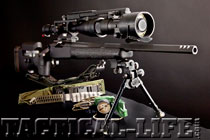 We also added Optical System Technology’s AN/PVS-22 Universal Night Sight (UNS) that is probably the best all around piece of image intensifying (I²) night vision equipment available because it can be used as a hand held night vision optic or as a small arms sight. Although the AN/PVS-22 is only slightly larger than an AN/PVS-14, it overshadows the AN/PVS-14’s performance in every way. The AN/PVS-22 has absolutely no sparkles, blooms or lines and when used as a night sight, mounts ahead of the day optic. The advantage to forward mounting is that the day optic can be used in darkness without an illuminated reticle and unlike night vision optics such as the AN/PVS-14 that must be mounted behind the scope with an adapter, eye relief with the AN/PVS-22 is the same regardless of whether or not the night vision device is in use.
We also added Optical System Technology’s AN/PVS-22 Universal Night Sight (UNS) that is probably the best all around piece of image intensifying (I²) night vision equipment available because it can be used as a hand held night vision optic or as a small arms sight. Although the AN/PVS-22 is only slightly larger than an AN/PVS-14, it overshadows the AN/PVS-14’s performance in every way. The AN/PVS-22 has absolutely no sparkles, blooms or lines and when used as a night sight, mounts ahead of the day optic. The advantage to forward mounting is that the day optic can be used in darkness without an illuminated reticle and unlike night vision optics such as the AN/PVS-14 that must be mounted behind the scope with an adapter, eye relief with the AN/PVS-22 is the same regardless of whether or not the night vision device is in use.
Advertisement — Continue Reading Below
Since our VTR was not equipped with a MIL-STD-1913 rail forward of the receiver to accommodate the AN/PVS-22, we used a La Rue Tactical Sniper Total Optical Mounting Package (STOMP) mount that has a MIL-STD-1913 rail cantilevered over and ahead the day optic to accommodate an AN/PVS-22. The STOMP mount facilitates mounting the AN/PVS-22 without affecting zero or eye relief and is especially designed for rifles such as our VTR that lack the ability to mount the latest night vision sights as standard equipment. The STOMP mount also provides a protective cage that surrounds and protects the scope from getting banged up during tactical operations, possibly affecting zero.
We obtained one of Keng’s Firearms latest Versa-Pods that we mounted to the rifle using the Uncle Mike’s forward sling swivel. We have always preferred Versa-Pods because the length of the bipod legs can be changed beyond the variable leg adjustment almost instantly. For example, if one goes from a prone position to sitting, Versa-Pod legs to support the different position can be installed in seconds, unlike others that require the entire bipod be removed to change leg height for different shooting positions. The new Versa-Pods are even better than earlier ones, with infinitely adjustable tensioning knobs for both the side-to-side rotation and front and rear leg angle. The shooter can literally set the tension for all bipod movement to any level he or she wishes.
Final Notes
As with any other device, the proof of the pudding was shooting Remington’s 700 VTR and the rifle delivers the goods! The bolt operated smoothly with zero binding and feeding was flawless. The integral muzzle brake performed as advertised and markedly reduced felt recoil and muzzle rise. Accuracy was excellent, with sub-MOA accuracy with all brands of ammo tested, despite the fact that we tested the rifle without breaking in the barrel and the trigger pull was on the high side, so once the rifle has a few hundred rounds through it, accuracy should be even better. The best group came with Black Hills 168-grain match ammo. Remington’s latest iteration of its classic 700 is better than ever and while you can pay a lot more for a precision tactical rifle, based on our test sample you just can’t get one that shoots much better!
Advertisement — Continue Reading Below
Specifications: REMINGTON 700 VTR
Caliber: .308Win
Barrel: 22 inches
OA Length: 41.625 inches
Weight: 7.5 pounds
Sights: Fixed
Stock: Polymer
Action: Bolt
Finish: Synthetic (OD green or Digital Tiger TSP Desert Camo)
Capacity: 4/5
Price: N/A
